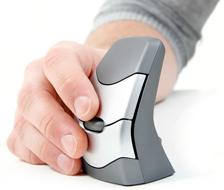What makes an ‘ergonomic’ mouse TRULY ergonomic?
 With International RSI Awareness Day just around the corner on February 28th, here at HWS, we have been looking at different ways we could help create awareness of RSI issues in the workplace, and indeed how we might offer some advice as to preventing them too. As we mentioned in a previous post, some products simply offer ergonomic features, while others truly excel in the field. You may wonder, therefore if many ergonomic mice are indeed truly ergonomic?
With International RSI Awareness Day just around the corner on February 28th, here at HWS, we have been looking at different ways we could help create awareness of RSI issues in the workplace, and indeed how we might offer some advice as to preventing them too. As we mentioned in a previous post, some products simply offer ergonomic features, while others truly excel in the field. You may wonder, therefore if many ergonomic mice are indeed truly ergonomic?
In this edition of the Blog we spotlight a quote highlighted by the creator of the DXT Mouse, Stephen Bowden, Managing Director of City Ergonomics in one of their reports:
“There appears to be evolving evidence, therefore, that many of the ergonomic shapes/designs have emerged for the wrong reasons”.
Some offer sloped palm and full hand support, others concentrate on reducing the load from the fingertips, relieving hand tension, or promoting the forearm to stay in a neutral position. Each of these designs is based on either individual perspectives or experiences, or on research-based claims, which can sometimes be conflicting.
So what makes an ergonomic mouse truly ergonomic?
Well first let’s outline the description of the term ‘ergonomic’ as a piece of equipment that provides optimum comfort and productivity and which ultimately avoids stress or injury upon the user. Since we are all different, wouldn’t it therefore be fair to say that what one person finds comfortable, another does not? This may be because we have different hand sizes, finger lengths and indeed practice different amounts of time using a mouse?
We have experienced various ‘ergonomic’ mice entering the market place. The unique features that are presented with the DXT mouse do, however, provide a lot of scope for individual variation; especially perhaps its ambidextrous and weightlessness design? Some mice designers place emphasis on arm movement rather than hand due to its larger muscle faculty; the designers of the DXT argue that this affects the precision of pointing and that a mouse which encourages use of the whole structure is better suited to users overall.
Given much thought to your mouse recently? Why not take a look at our fact sheet highlighting “why it hurts”?

